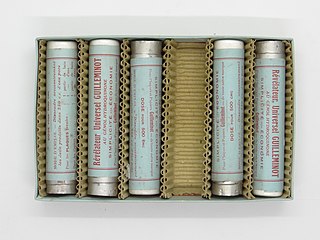
Film stock is an analog medium that is used for recording motion pictures or animation. It is a strip or sheet of transparent plastic film base coated on one side with a gelatin emulsion containing microscopically small light-sensitive silver halide crystals. The sizes and other characteristics of the crystals determine the sensitivity, contrast and resolution of the film. The emulsion will gradually darken if left exposed to light, but the process is too slow and incomplete to be of any practical use. Instead, a very short exposure to the image formed by a camera lens is used to produce only a very slight chemical change, proportional to the amount of light absorbed by each crystal. This creates an invisible latent image in the emulsion, which can be chemically developed into a visible photograph. In addition to visible light, all films are sensitive to X-rays and high-energy particles. Most are at least slightly sensitive to invisible ultraviolet (UV) light. Some special-purpose films are sensitive into the infrared (IR) region of the spectrum.
Photographic processing or photographic development is the chemical means by which photographic film or paper is treated after photographic exposure to produce a negative or positive image. Photographic processing transforms the latent image into a visible image, makes this permanent and renders it insensitive to light.

Photographic paper is a paper coated with a light-sensitive chemical formula, used for making photographic prints. When photographic paper is exposed to light, it captures a latent image that is then developed to form a visible image; with most papers the image density from exposure can be sufficient to not require further development, aside from fixing and clearing, though latent exposure is also usually present. The light-sensitive layer of the paper is called the emulsion. The most common chemistry was based on silver salts but other alternatives have also been used.

In the processing of photographic films, plates or papers, the photographic developer is one or more chemicals that convert the latent image to a visible image. Developing agents achieve this conversion by reducing the silver halides, which are pale-colored, into silver metal, which is black. The conversion occurs within the gelatine matrix. The special feature of photography is that the developer acts more quickly on those particles of silver halides that have been exposed to light. Paper left in developer will eventually reduce all the silver halides and turn black. Generally, the longer a developer is allowed to work, the darker the image.

The gelatin silver process is the photographic process used with currently available black-and-white films and printing papers. A suspension of silver salts in gelatin is coated onto a support such as glass, flexible plastic or film, baryta paper, or resin-coated paper. These light-sensitive materials are stable under normal keeping conditions and are able to be exposed and processed even many years after their manufacture. This is in contrast to the collodion wet-plate process dominant from the 1850s–1880s, which had to be exposed and developed immediately after coating.
Photographic printing is the process of producing a final image on paper for viewing, using chemically sensitized paper. The paper is exposed to a photographic negative, a positive transparency , or a digital image file projected using an enlarger or digital exposure unit such as a LightJet printer. Alternatively, the negative or transparency may be placed atop the paper and directly exposed, creating a contact print. Digital photographs are commonly printed on plain paper, for example by a color printer, but this is not considered "photographic printing".

Photogravure is an intaglio printmaking or photo-mechanical process whereby a copper plate is grained and then coated with a light-sensitive gelatin tissue which had been exposed to a film positive, and then etched, resulting in a high quality intaglio plate that can reproduce detailed continuous tones of a photograph.
C-41 is a chromogenic color print film developing process introduced by Kodak in 1972, superseding the C-22 process. C-41, also known as CN-16 by Fuji, CNK-4 by Konica, and AP-70 by AGFA, is the most popular film process in use, with most photofinishing labs devoting at least one machine to this development process.

A carbon print is a photographic print with an image consisting of pigmented gelatin, rather than of silver or other metallic particles suspended in a uniform layer of gelatin, as in typical black-and-white prints, or of chromogenic dyes, as in typical photographic color prints.
Color prints have been developed since their beginnings in 1935 with Eastman Kodak’s Company’s Kodachrome film, as well in 1936 with Agfa Company’s Agfacolor film. Color print film is the most common type of photographic film in consumer use. Print film produces a negative image when it is developed, requiring it to be reversed again when it is printed onto photographic paper.

Hand-colouring refers to any method of manually adding colour to a black-and-white photograph, generally either to heighten the realism of the photograph or for artistic purposes. Hand-colouring is also known as hand painting or overpainting.
The conservation and restoration of photographs is the study of the physical care and treatment of photographic materials. It covers both efforts undertaken by photograph conservators, librarians, archivists, and museum curators who manage photograph collections at a variety of cultural heritage institutions, as well as steps taken to preserve collections of personal and family photographs. It is an umbrella term that includes both preventative preservation activities such as environmental control and conservation techniques that involve treating individual items. Both preservation and conservation require an in-depth understanding of how photographs are made, and the causes and prevention of deterioration. Conservator-restorers use this knowledge to treat photographic materials, stabilizing them from further deterioration, and sometimes restoring them for aesthetic purposes.
Chromogenic refers to photographic processes that work by forming a conventional silver image and then replacing it with a dye image. Most films and papers used for color photography today are chromogenic.
A chromogenic print, also known as a silver halide print, or a dye coupler print, is a photographic print made from a color negative, transparency, or digital image, and developed using a chromogenic process. They are composed of three layers of gelatin, each containing an emulsion of silver halide, which is used as a light-sensitive material, and a different dye coupler of subtractive color which together, when developed, form a full-color image.

Color motion picture film refers both to unexposed color photographic film in a format suitable for use in a motion picture camera, and to finished motion picture film, ready for use in a projector, which bears images in color.
Photographic emulsion is a light-sensitive colloid used in film-based photography. Most commonly, in silver-gelatin photography, it consists of silver halide crystals dispersed in gelatin. The emulsion is usually coated onto a substrate of glass, films, paper, or fabric.
Dye transfer is a continuous-tone color photographic printing process. It was used to print Technicolor films, as well as to produce paper colour prints used in advertising, or large transparencies for display.

Photographic film is a strip or sheet of transparent plastic film base coated on one side with a gelatin emulsion containing microscopically small light-sensitive silver halide crystals. The sizes and other characteristics of the crystals determine the sensitivity, contrast, and resolution of the film.
Art photography print types refers to the process and paper of how the photograph is printed and developed.

The conservation and restoration of photographic plates is the process of caring for and maintaining photographic plates in order to preserve their materials and content. It covers the necessary measures that can be taken by conservators, curators, collections managers, and other museum professionals to conserve the material unique to photographic plate processes. This practice includes understanding the composition and agents of deterioration of photographic plates, as well as the preventive conservation and interventive conservation measures that can be taken to increase their longevity.









